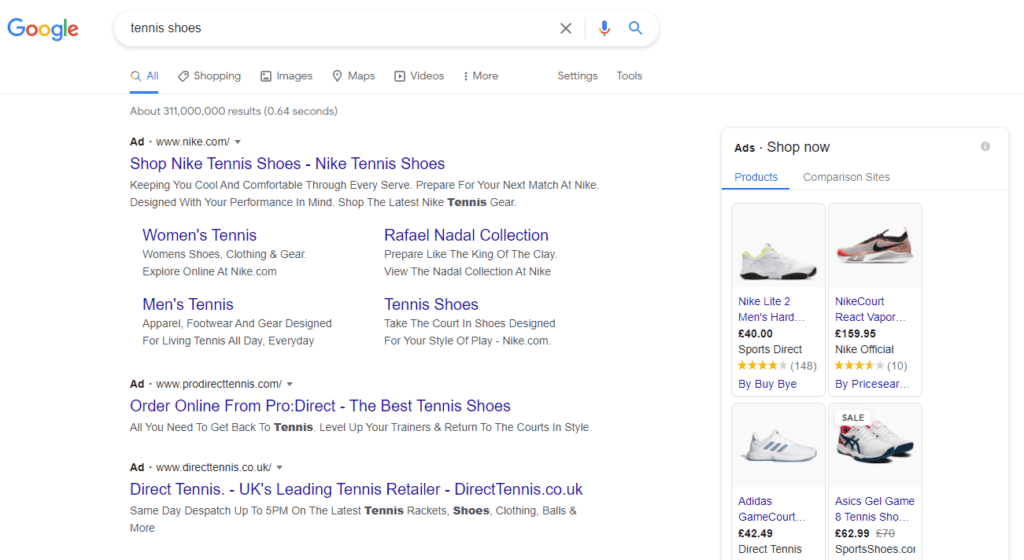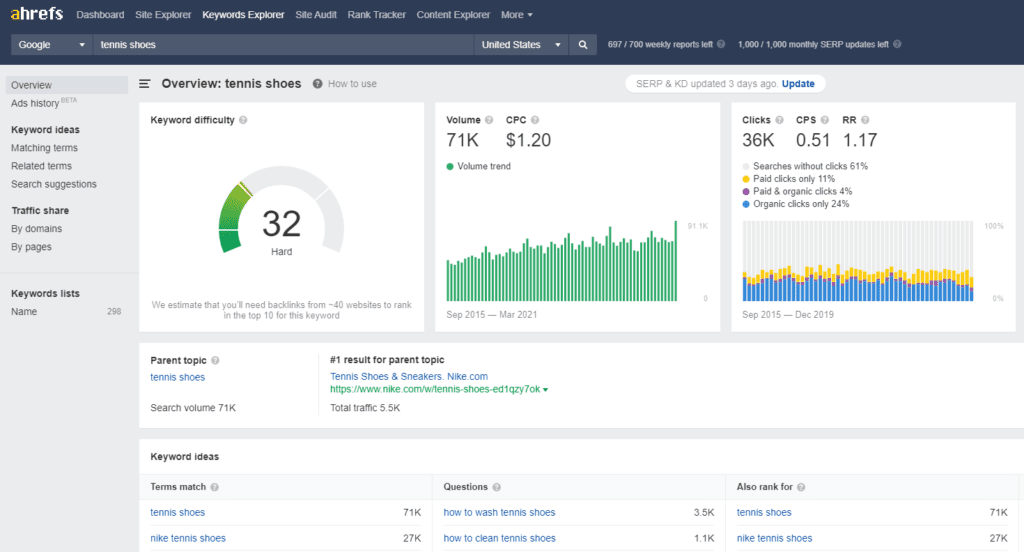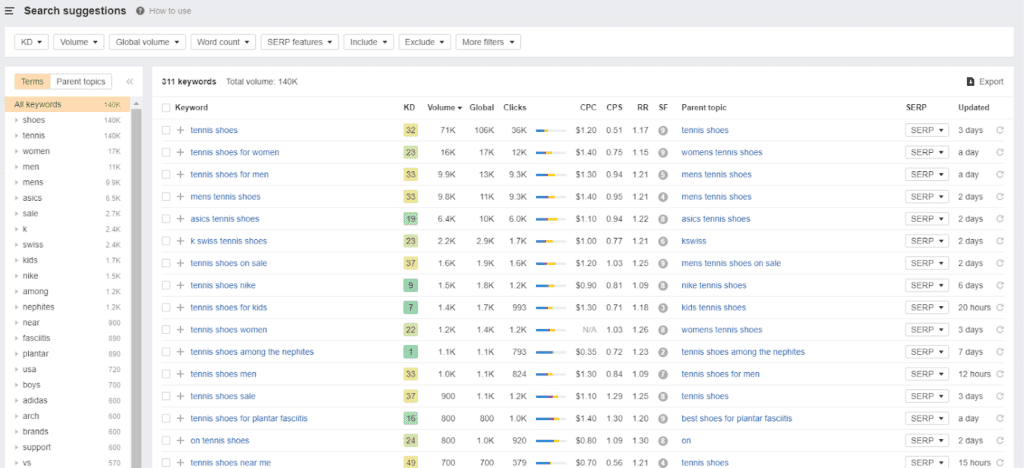Latent Semantic Indexing (LSI) – also known as latent semantic analysis – is a technical process that can help to classify and retrieve information on specific terms and concepts.
But let’s be real here: As a vendor or affiliate marketer, what YOU care about is getting more organic traffic to drive more sales and make more money online!
Fortunately, using LSI in SEO can make a huge difference for your content’s ranking. It all starts with recognising and including the LSI keywords related to the search term you’re targeting on your website.
LSI keywords are similar keywords within your content that signal the relevance of your topic or theme and, in turn, boost your overall SEO performance.
If you end up ranking for one keyword, the likelihood of ranking for related terms seems fairly reasonable – but this isn’t necessarily the case, and there are differing opinions on how much LSI can really boost your content in organic search.
Search engines like Google have become increasingly intelligent when it comes to the various factors that can influence your ranking in the SERPs. In fact, nothing 100% guarantees that latent semantic indexing has anything to do with the way Google’s algorithms determine what content is relevant and what isn’t (though it seems likely that it’s at least partially relevant).
But before we dig deeper into the true power of LSI and how to harness its power for your ecommerce store or affiliate site, let’s take a moment to explore what it is exactly and how it’s relevant to content creation!
What is Latent Semantic Indexing (LSI)?
Latent semantic indexing utilises natural language processing (NLP) to help search engines figure out which content is relevant for specific queries.
For instance, you run a search for ‘tennis shoes.’ While these two words will return different results when searched individually, the semantics change when they’re combined. So, how does a search engine know to return the right sneakers in its results, rather than information related to tennis or more formal shoes?

Google uses LSI keywords to understand the context of pages containing the words ‘tennis shoes’ to provide more relevant results. Results containing this term are also likely to feature LSI phrases like ‘trainers,’ ‘sneakers,’ and ‘sports shoes’ – enabling the search engine to pick out the most relevant pages based on the most likely search intent.
For companies aiming to ramp up their marketing efforts, LSI keywords should be regarded as essential practice within any content strategy.

(Image: WordStream)
In the diagram above, we can see how Google’s crawlers identifies the wider context of pages through LSI, with context-generating buzzwords highlighted for the purpose of better categorisation.
Content that’s created with LSI in mind can make searches for company products and services more effective and productive for users. This can help to position your brand as a go-to resource for individuals looking for the best and most reliable solution to their queries or the product searches.
Why Latent Semantic Indexing is Vital to SEO
As it was still developing into the all-encompassing online entity we know it as today, Google recognised that early search engines were ranking websites based on the frequency of certain keywords. However, this system doesn’t guarantee the most relevant search results. Instead, Google chose to rank websites based on more tangible metrics surrounding the wider context of content and the trustworthiness of the publishers.
Google’s algorithms evolved to filter out irrelevant or poor quality matches with greater degrees of success over recent years, helping marketers to better understand how to rank for more relevant searches, rather than simply stuffing content with specific keywords.
To further elaborate on how Google views various forms of searches, the search engine giants maintain a document called Search Quality Evaluator Guidelines, which detail various forms of user intent:
- Know queries represent the pursuit of information surrounding a specific topic. This also features a subset known as the ‘know simple’ query – which occurs when users are running a search with a single specific answer in mind.
- Do queries revolve around the user’s intentions for engaging in a certain activity like an online purchase or software download.
- Website queries refer to when users are searching with the intention of finding a specific website or webpage. These searches typically involve some form of pre-existing awareness for a company or its website.
- Visit-in-person queries relate to when a user is searching for a geographical location with the intention of visiting – like a local branch of a bank or a certain type of restaurant.
By enabling their algorithms to interpret the LSI context behind certain search terms and the type of search being carried out, Google was able to gain a competitive advantage over its competitors and produce a more relevant range of results to aid the convenience of its users.
How to Use LSI in SEO to Your Advantage
Because context matters when it comes to producing content that can be crawled and categorised appropriately by Google, it’s worth taking the time to explore the relevant LSI keywords that you can add to your content.
There are insights you can gain into which terms will add context to the content that you produce.

(Image: Keyword Tool Dominator)
One of the best ways to anticipate what Google is looking for within your content is to go directly to the search engine and explore its autocomplete function. In the example above, we can see the sort of things that Google associates with the term ‘best cell phone that…,’ helping to inspire some ideas on how best to rank for relevant searches.

There are other dedicated platforms that offer more comprehensive overviews of LSI keywords and their respective search volume. In the example above, we can see how the LSI Graph platform helps to automatically generate latent semantic indexing terms to support our ‘tennis shoes’ content.
By throwing up broader terms and their associated search volume and cost-per-click, we can gain a deeper insight into which words are the most valuable to include within your content.
Another simple giveaway as to what potential LSI keywords to include in your content can be found in Google’s ‘searches related to’ section, which is displayed within query results pages.

Again, this helps content creators and marketers to better understand how Google utilises search terms in order to deliver relevant results. If you happen to be preparing an article surrounding tennis shoes, the example above shows that brands like Adidas, Nike and Asics are heavily associated with the product, while Google attributes terms like ‘women’s tennis shoes’ and ‘tennis shoes ladies’ as a significant indicator of search intent.
Make SEO Tools Your Friend
Although there are some great free techniques to help you to identify some strong LSI keywords, you can bolster your efficiency in spotting the right terms to suit your content by enlisting the help of more premium SEO tools and platforms.
There are few better tools out there than Ahrefs and SEMRush when it comes to helping your search engine optimisation efforts, and both tools can be excellent in helping you to find and use LSI keywords.

As we can see from the image above, Ahrefs offers a comprehensive overview of the keywords you’re aiming to rank for – including its search volume and estimated cost-per-click.
Significantly, Ahrefs also provides a ‘keyword difficulty’ score out of 100, which helps businesses to better understand what’s needed for them to rank efficiently for specific terms. In the case of our example, Ahrefs estimates that we would need backlinks from around 40 websites in order to rank in Google’s top 10 SERPs – so there’s a lot of work to do.

On the left-hand menu of Ahrefs’ keyword explorer, we can see a ‘search suggestions’ option. By clicking this, we can see a host of LSI keywords connected to the topic, all with their own colour-coded keyword difficulty. This is highly important in clarifying which terms your business can enter into the top 10 SERPs for, and whether such terms attract a larger level of search volume along the way.
For instance, the search suggestion above shows that the LSI keyword ‘tennis shoes nike’ has a relatively easy keyword difficulty of 9 – meaning that websites would only need around 10 backlinks to rank in the top 10 SERPs. With data suggesting that this keyword attracts an average of 1,200 clicks per month, it could be a great way for businesses to draw in a steady stream of traffic.

Ahrefs also offers up further keyword ideas and an estimated cost-per-click for the benefit of advertisers and budgeting. Metrics available can tell websites where global search volumes come from, which can play a key role in helping businesses to understand what audiences they’re marketing to.
It’s also worth businesses paying attention to the ‘also talk about’ table to the bottom-right of the image above, which displays other keywords which aren’t semantically linked to the terms that you’re hoping to rank for but are connotatively linked. This can make for a great source of inspiration for content creators.

(Image: E2M)
SEMRush also has a great system that enables users to enter a keyword and search for LSI keywords in the ‘related keywords’ section of the platform. Once these keywords are identified, the next step is to choose the most relevant keywords to suit your content.
Both tools painstakingly work to colour-coordinate your content to ensure that picking up the right LSI keywords for your content is as simple as possible.
While these are premium tools, they can certainly be a valuable asset in making the identification of LSI keywords as quick and easy as possible.
Don’t Limit Yourself to LSI Keywords Synonyms
As you become more proficient at finding valuable LSI keywords, bear in mind that you’re not simply looking for synonyms alone. It’s vital that you should also seek to spot related terms, phrases and buzzwords. By adopting this mindset, you can operate by optimising the most valuable terms associated with your keywords and find much greater contextual relevance.
For instance, if you were looking to target the keyword ‘best tennis shoes,’ you wouldn’t simply look to utilise synonyms like ‘high quality sneakers’ or ‘great trainers.’ The best practice here is to build a list of related and relevant terms that emanate from the concept. These related terms can revolve around what exactly makes tennis shoes ‘great’ in the minds of customers. Focus on ‘high-performance tennis shoes’ or ‘value for money trainers’ as well as focusing on the various types of tennis shoes and their use cases – whether users want to buy them for sport or for fashion.
Contextual awareness of your product is essential here, and you’ll likely already have a strong idea of the sort of customers you want to attract. To continue with the tennis shoes analogy, we can consider the type of business you are. You may be a shoe shop, a sports shop, or a fashion retailer. Your business model will be a strong indicator as to how you can utilise the right terms as LSI keywords to accompany your copy.
Using On Page Optimisation Tools to Pick Keywords for Google
To help you get the most mileage out of your content – and maximise your odds of ranking – there are a handful of on-page optimisation tools that streamline this whole process. Whether you’re using Surfer SEO, Frase, MarketMuse, or PageOptimizer Pro, the process for incorporating LSI keywords is similar across any on page optimisation tool:
- Pick a blog topic and primary search term and start a new page within the tool.
- Wait while the tool evaluates all of the top competitors whose content is currently ranking in the top of Google (typically focused on just the first 10-20 positions).
- Write content in the tool’s content editor while incorporating recommended keywords from the tool.
- Add different LSI keywords until you have an optimal frequency for the suggested word count.

This isn’t an exact science by any means, but on page optimisation tools go farther than a tool like Ahrefs – rather than simply suggesting some keywords you can include, a tool like Surfer will actively compare your current content against the target you’re aiming for.
Not only does it tell you which keywords you should include, it also tells you where – like in the subheads versus body of the post – and suggests an upper limit to avoid keyword stuffing.
Monitoring LSI Performance in Your Content
Google’s algorithms are profoundly tricky for marketers to understand, which makes the production of content difficult to master. Stuffing your text with keywords is a sure fire way of devaluing your content – particularly when you neglect the quality of your work for the quantity of more relevant words. However, incorporating relevant LSI keywords can be great for adding vital context to for Google to better understand and categorise your content.
For this, it may be worth utilising the help of analytical tools like Google Analytics or Finteza, which can help users to comprehensively monitor how their pages perform in terms of attracting and retaining traffic.

Audience insights like the one provided by Finteza in the image above can tell users a wealth of information surrounding how visitors interact with specific landing pages, how long they stay engaging with content and how they move through your site.
By varying your approach to LSI keywords within your content you can quickly determine which texts are performing better than others and work to refine your approach in a more efficient way.
Although Google’s SERPs can be tricky to master, latent semantic indexing can play a key role in ensuring that your content is displayed to the right audience in the most helpful way. In this regard, building better contexts for your content can pave the way for greater prominence.
Author Bio: Dmytro is a CEO at Solvid, a creative content creation agency based in London. Founder of Pridicto. His work has been published in Shopify, Zapier, Mention, WordStream, Entrepreneur, Scoop.it, BuzzSumo, and Campaign Monitor.






